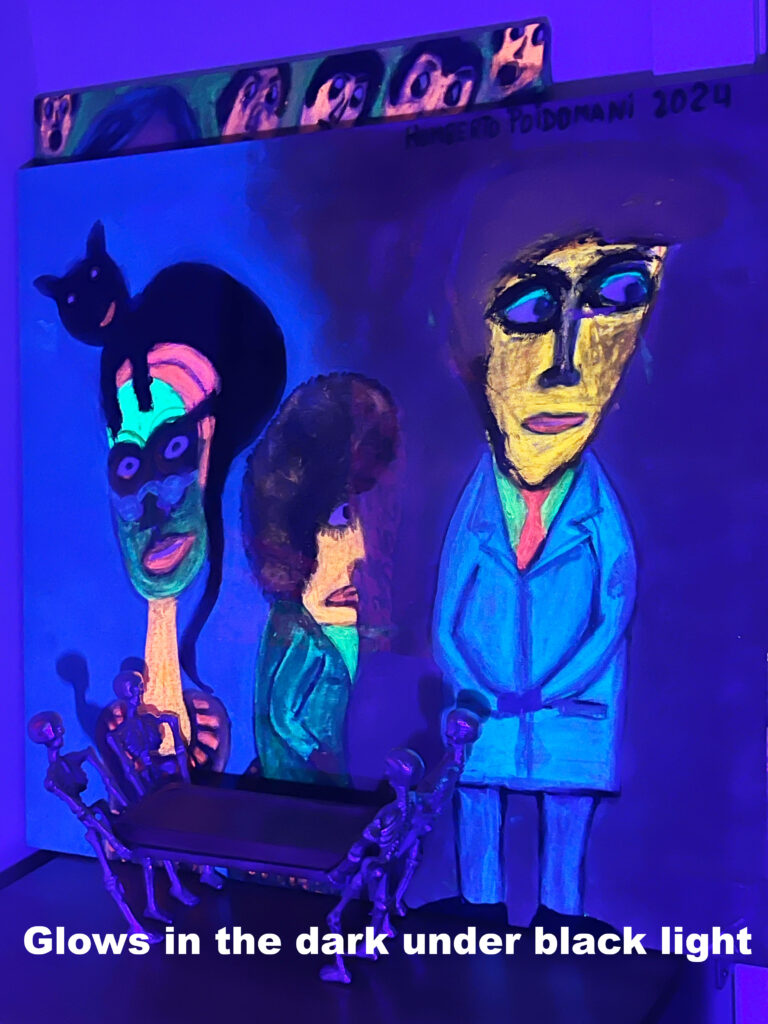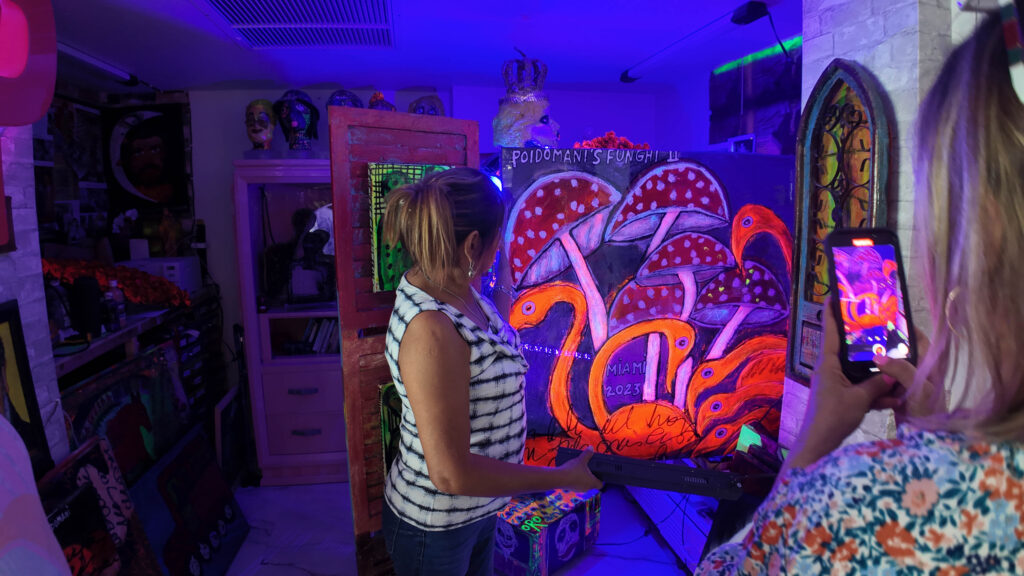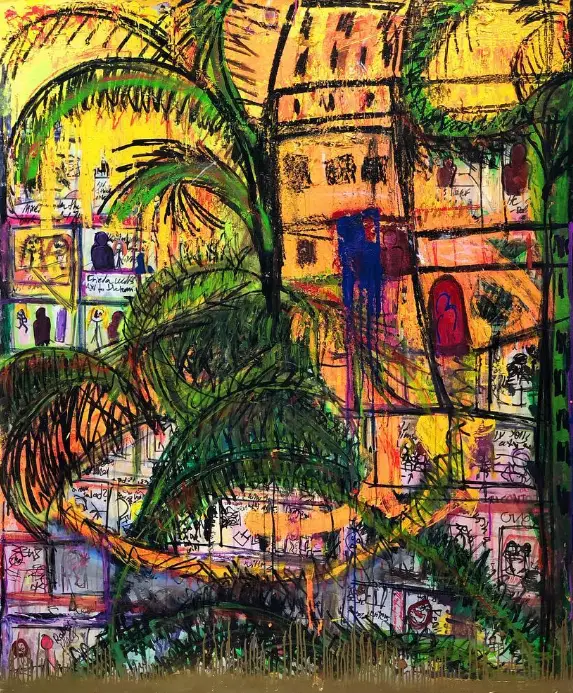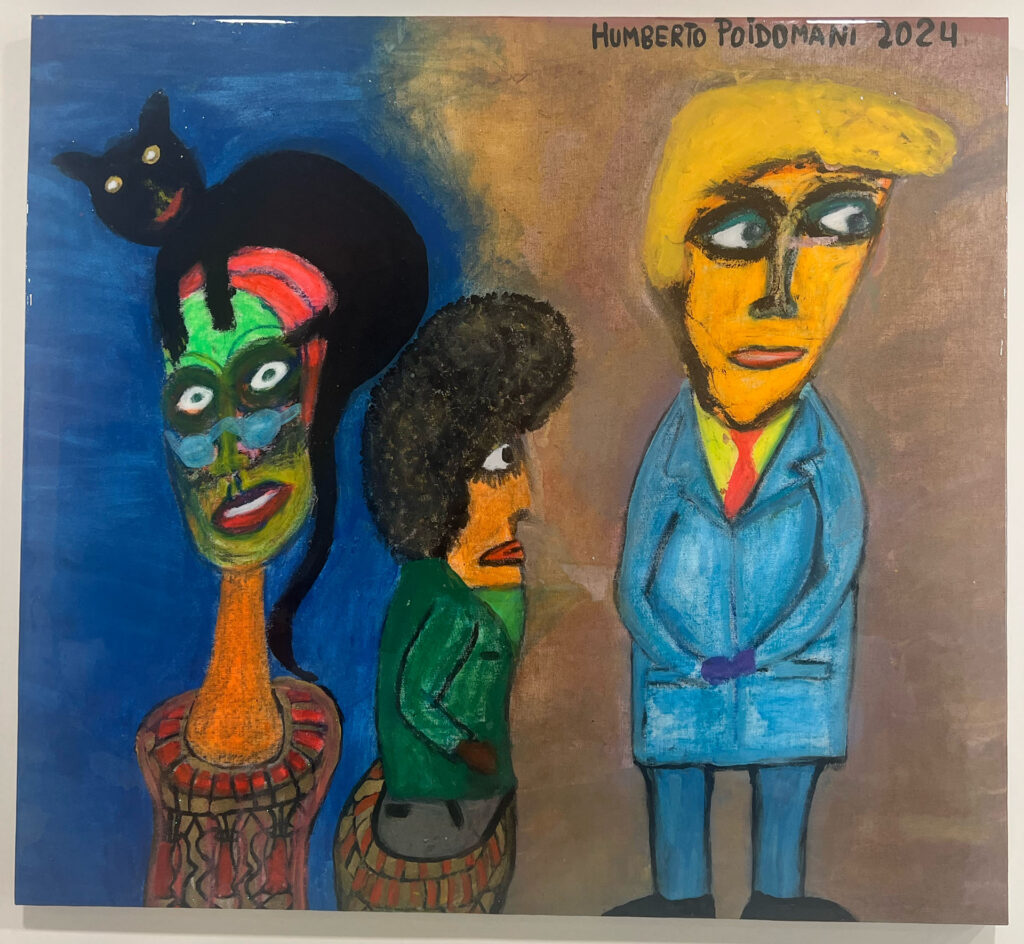Black light art, a fascinating genre that blends art and science, continues to captivate contemporary art enthusiasts, art collectors, and interior designers alike. Using ultraviolet (UV) light to reveal hidden layers of fluorescent paint, black light art creates mesmerizing effects that can transform modern and contemporary spaces. Whether it’s the vibrant glow of a painting or the dynamic interplay between light and shadow, this art form opens up unique possibilities for art collectors and contemporary artists to explore.
As the demand for innovative and immersive art grows, black light art offers aesthetic appeal and a compelling opportunity for art investments, particularly with contemporary artists from Argentina like Humberto Poidomani, who utilize this medium to convey deeper ideological and social messages. In this article, we’ll dive into the science, history, and potential applications of black light art, showing how it can embellish modern spaces while also serving as a valuable asset for art collectors.
Understanding Black Light Art and Fluorescent Light
At its core, black light art leverages ultraviolet (UV) radiation to illuminate certain materials that contain fluorescent pigments. Black lights, typically operating in the UV-A spectrum (320–400 nm), emit a purplish glow that is invisible to the human eye but causes fluorescent materials to emit visible light. This reaction is responsible for the glowing effect central to black light art.
Fluorescent pigments, such as those found in specially designed acrylic paints, absorb UV light and re-emit it as visible light. These pigments often contain zinc sulfide or cadmium sulfide, chemicals that create the glowing effects seen in many black light installations. When black light hits the fluorescent paint on an artwork, certain areas “pop,” creating a sharp contrast with the non-fluorescent regions.
While black light art has roots in the psychedelic art movements of the 1960s, it has since evolved into a dynamic tool for contemporary artists experimenting with light, color, and texture.
Black Light Art’s Historical Context: From Psychedelic to Contemporary
Black light art gained widespread popularity during the mid-20th century, particularly during the psychedelic art movement, when artists sought to create mind-bending, visually stimulating experiences. This was a period of experimentation, during which UV light installations illuminated vibrant murals and graffiti, giving the artwork a surreal, almost dreamlike quality. Psychedelic street art and large-scale murals began to incorporate black light elements, further pushing the boundaries of what visual art could achieve.
Fast-forward to today, and contemporary artists continue to explore the potential of black light art, using it in galleries, installations, and even private collections. Contemporary artists, such as those from Argentina, are integrating this technique into their works, taking the medium beyond its psychedelic roots and placing it firmly in the realm of modern art.
One such artist is Humberto Poidomani, an acclaimed contemporary artist from Argentina known for his innovative use of found materials and ideological themes. Poidomani’s work often delves into social crisis, decay, and environmental degradation themes. Incorporating black light elements into his sculptures and installations adds another layer of depth, emphasizing modern life’s hidden or forgotten aspects. Poidomani’s work is an excellent example of how black light art can elevate contemporary installations, visually and intellectually engaging the audience.
How Black Light Art Can Embellish Contemporary Spaces
For interior designers, black light art presents a bold and innovative way to embellish modern and contemporary spaces. The luminous glow and shifting tones under black light add a dynamic layer to any room, whether a sleek minimalist office or a vibrant living room.
By placing a black light painting or installation in an otherwise neutral space, designers can create a striking contrast that draws attention and creates focal points within the room. These works of art interact with both standard and UV lighting, creating a dual experience for viewers. For example, during the day, a black light painting might appear as a standard acrylic work of art, but when night falls and the UV lights are turned on, the fluorescent pigments come alive, transforming the artwork into a glowing, ethereal centerpiece.
This duality makes black light art versatile for a wide range of settings, from intimate residential spaces to large-scale commercial installations. In art galleries and public exhibitions, black light art is often used to create immersive environments that challenge the viewer’s perception, inviting them to engage with the artwork in a way that is both visual and emotional.
Aesthetic and Ideological Use in Contemporary Art
Black light art adds more than just visual appeal; it can also convey deeper symbolic meanings. Artists like Humberto Poidomani use black light to underscore the contrast between what is seen and what is hidden, much like how societal issues are often concealed beneath the surface. In Poidomani’s works, the glowing UV elements could symbolize societal decay or environmental neglect. At the same time, the dark, untouched areas represent the unseen yet pressing issues.
For contemporary artists, black light art offers a unique medium to communicate ideological tensions. The glow of fluorescent pigments can be used to represent the fragility of life, the transient nature of human existence, or the stark contrast between prosperity and poverty. As black light reveals the “hidden” aspects of the artwork, it invites viewers to contemplate what else may be hidden in plain sight in society.
Art Investments and Black Light Art
As the art world increasingly embraces interactive and multimedia pieces, black light art offers an exciting opportunity for art collectors and art investors. The novelty of this art form, combined with its technical and aesthetic complexities, can increase the value of pieces, especially if created by renowned artists like Poidomani, who are known for pushing artistic boundaries.
Investing in black light art requires consideration of the visual impact and its long-term preservation. UV light, while essential for revealing the fluorescent elements, can degrade certain pigments and materials over time. This poses challenges for both artists and collectors in terms of conservation. To maintain the artwork’s value, collectors must ensure that pieces are displayed under controlled lighting conditions and protected from prolonged UV exposure. Protecting and preserving UV-sensitive materials ensures that art investments remain sound for today’s visual enjoyment and tomorrow’s financial security.
For investors looking to diversify their portfolios, acquiring black light art pieces from contemporary artists, particularly those emerging from regions like Argentina, presents a unique opportunity. Artists like Poidomani, who have international recognition, are positioned to see their work appreciate over time, making them a solid choice for both seasoned art investors and those new to the market.
Black Light in Exhibitions and Public Spaces
Museums and galleries are increasingly incorporating black-light art into their exhibits, using it to create multi-dimensional, immersive experiences. When select pieces are displayed under UV light, viewers can engage with the artwork differently, enhancing their emotional response and encouraging deeper interaction. The black-light elements make the artwork dynamic, adding layers that are only visible under specific lighting conditions.
Black light art can create a sense of wonder and intrigue in public art installations. For instance, urban murals using UV-responsive pigments come alive at night, transforming otherwise static works into glowing displays that interact with the surrounding environment. In large outdoor installations, black light can highlight specific architectural elements or enhance the interplay between natural light and the artwork, creating a sense of movement and fluidity.
Conservation and Preservation Issues
While the visual effects of black light art are stunning, they come with certain conservation challenges. UV light can degrade materials, particularly organic pigments, over time. For artists and collectors, this means finding ways to protect the pieces from excessive UV exposure while still allowing for the interactive elements to shine.
For art collectors and investors, this involves ensuring that pieces are stored and displayed in environments with minimal direct UV exposure. Using UV-filtering glass or acrylic in framing and avoiding excessive use of UV light will help prolong the life of black light artworks, ensuring they remain valuable investments for years.
Conclusion
In conclusion, black light art uniquely enhances contemporary spaces, bridging the gap between science, art, and ideology. For interior designers and contemporary art enthusiasts, incorporating black light pieces into modern spaces can create dynamic, immersive experiences that transform the ordinary into the extraordinary. For artists, such as Argentina’s Humberto Poidomani, black light art serves as a tool to convey deeper societal messages, while for art collectors and investors, these works present promising opportunities for both aesthetic appreciation and art investments.
With its bold visual impact and symbolic depth, black light art is poised to continue captivating audiences and pushing the boundaries of contemporary art. Whether displayed in a private collection, public space, or commercial gallery, this genre of art opens up new possibilities for artistic expression and investment in the modern world.
Art Trends 2024 and Beyond: Black Light Art’s Role in the Future
As we look ahead to art trends 2024, black light art is emerging as a key player in the realm of immersive and interactive art. With its captivating blend of fluorescent pigments and UV light, this genre aligns with the growing demand for art that not only decorates a space but also transforms it into an engaging experience. Art trends 2025 are set to further push the boundaries of light-based installations, where the use of black light in art galleries and private collections will become increasingly sought-after for its unique ability to reveal hidden layers and meaning in a work of art.





